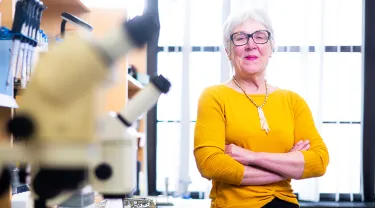When a tooth is damaged, either by severe decay or trauma, the living tissues that make up the sensitive inner dental pulp become exposed and vulnerable to harmful bacteria. Once infection takes hold, few treatment options—primarily root canals or tooth extraction—are available to alleviate the painful symptoms.
Researchers at Tufts University School of Dental Medicine (TUSDM) have shown, however, that using a collagen-based biomaterial to deliver stem cells inside damaged teeth can regenerate dental pulp-like tissues in animal model experiments. Their findings support the potential of this approach as part of a strategy for restoring natural tooth functionality.
“Endodontic treatment, such as a root canal, essentially kills a once-living tooth. It dries out over time, becomes brittle, and can crack, and eventually it might have to be replaced with a prosthesis,” said senior study author Pamela Yelick, professor of orthodontics at TUSDM and director of its Division of Craniofacial and Molecular Genetics. “Our findings validate the potential of an alternative approach to endodontic treatment, with the goal of regenerating a damaged tooth so that it remains living and functions like any other normal tooth.”
Yelick and her colleagues examined the safety and efficacy of gelatin methacrylate (GelMA)—a low-cost hydrogel derived from naturally occurring collagen—as a scaffold to support the growth of new dental pulp tissue. Using GelMA, the team encapsulated a mix of human dental pulp stem cells—obtained from extracted wisdom teeth—and endothelial cells, which accelerate cell growth.
This mix was delivered into isolated, previously damaged human tooth roots, which were extracted from patients as part of unrelated clinical treatment and sterilized of remaining living tissue. The roots were then implanted and allowed to grow in a rodent animal model for up to eight weeks.
Increased cell growth and the formation of blood vessels occurred after four weeks. At the eight-week mark, pulp-like tissue filled the entire dental pulp space, complete with highly organized blood vessels populated with red blood cells.
“We are excited for the possibility of someday giving patients the option of regenerating their own teeth,” said Yelick.
Stem Cells Allow Damaged Tooth Roots to Regenerate Tissue
Tufts University School of Dental Medicine researchers restore natural function to a tooth through an alternative to endodontic treatment
